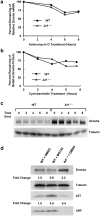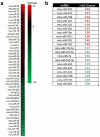The ARF tumor-suppressor controls Drosha translation to prevent Ras-driven transformation
- PMID: 23318441
- PMCID: PMC3934099
- DOI: 10.1038/onc.2012.601
The ARF tumor-suppressor controls Drosha translation to prevent Ras-driven transformation
Abstract
ARF is a multifunctional tumor suppressor that acts as both a sensor of oncogenic stimuli and as a key regulator of ribosome biogenesis. Recently, our group established the DEAD-box RNA helicase and microRNA (miRNA) microprocessor accessory subunit, DDX5, as a critical target of basal ARF function. To identify other molecular targets of ARF, we focused on known interacting proteins of DDX5 in the microprocessor complex. Drosha, the catalytic core of the microprocessor complex, has a critical role in the maturation of specific non-coding RNAs, including miRNAs and ribosomal RNAs (rRNAs). Here, we report that chronic or acute loss of Arf enhanced Drosha protein expression. This induction did not involve Drosha mRNA transcription or protein stability but rather relied on the increased translation of existing Drosha mRNAs. Enhanced Drosha expression did not alter global miRNA production but rather modified expression of a subset of miRNAs in the absence of Arf. Elevated Drosha protein levels were required to maintain the increased rRNA synthesis and cellular proliferation observed in the absence of Arf. Arf-deficient cells transformed by oncogenic Ras(V12) were dependent on increased Drosha expression as Drosha knockdown was sufficient to inhibit Ras-dependent cellular transformation. Thus, we propose that ARF regulates Drosha mRNA translation to prevent aberrant cell proliferation and Ras-dependent transformation.
Figures







Similar articles
-
P19ARF and RasV¹² offer opposing regulation of DHX33 translation to dictate tumor cell fate.Mol Cell Biol. 2013 Apr;33(8):1594-607. doi: 10.1128/MCB.01220-12. Epub 2013 Feb 11. Mol Cell Biol. 2013. PMID: 23401854 Free PMC article.
-
Drosha regulates hMSCs cell cycle progression through a miRNA independent mechanism.Int J Biochem Cell Biol. 2011 Nov;43(11):1563-72. doi: 10.1016/j.biocel.2011.07.005. Epub 2011 Jul 20. Int J Biochem Cell Biol. 2011. PMID: 21794839 Free PMC article.
-
RNA helicase DDX5 is a p53-independent target of ARF that participates in ribosome biogenesis.Cancer Res. 2011 Nov 1;71(21):6708-17. doi: 10.1158/0008-5472.CAN-11-1472. Epub 2011 Sep 21. Cancer Res. 2011. PMID: 21937682 Free PMC article.
-
Hypergrowth mTORC1 signals translationally activate the ARF tumor suppressor checkpoint.Mol Cell Biol. 2012 Jan;32(2):348-64. doi: 10.1128/MCB.06030-11. Epub 2011 Nov 7. Mol Cell Biol. 2012. PMID: 22064482 Free PMC article.
-
MicroRNA biogenesis: isolation and characterization of the microprocessor complex.Methods Mol Biol. 2006;342:33-47. doi: 10.1385/1-59745-123-1:33. Methods Mol Biol. 2006. PMID: 16957365 Review.
Cited by
-
PTRE-seq reveals mechanism and interactions of RNA binding proteins and miRNAs.Nat Commun. 2018 Jan 19;9(1):301. doi: 10.1038/s41467-017-02745-0. Nat Commun. 2018. PMID: 29352242 Free PMC article.
-
The ARF tumor suppressor targets PPM1G/PP2Cγ to counteract NF-κB transcription tuning cell survival and the inflammatory response.Proc Natl Acad Sci U S A. 2020 Dec 22;117(51):32594-32605. doi: 10.1073/pnas.2004470117. Epub 2020 Dec 7. Proc Natl Acad Sci U S A. 2020. PMID: 33288725 Free PMC article.
-
It's Getting Complicated-A Fresh Look at p53-MDM2-ARF Triangle in Tumorigenesis and Cancer Therapy.Front Cell Dev Biol. 2022 Jan 26;10:818744. doi: 10.3389/fcell.2022.818744. eCollection 2022. Front Cell Dev Biol. 2022. PMID: 35155432 Free PMC article. Review.
-
p19(Arf) limits primary vitreous cell proliferation driven by PDGF-B.Exp Eye Res. 2016 Apr;145:224-229. doi: 10.1016/j.exer.2016.01.004. Epub 2016 Jan 8. Exp Eye Res. 2016. PMID: 26778750 Free PMC article.
-
Upregulation of 5'-terminal oligopyrimidine mRNA translation upon loss of the ARF tumor suppressor.Sci Rep. 2020 Dec 17;10(1):22276. doi: 10.1038/s41598-020-79379-8. Sci Rep. 2020. PMID: 33335292 Free PMC article.
References
-
- Quelle DE, Zindy F, Ashmun RA, Sherr CJ. Alternative reading frames of the INK4a tumor suppressor gene encode two unrelated proteins capable of inducing cell cycle arrest. Cell. 1995;83:993–1000. - PubMed
-
- Weber JD, Taylor LJ, Roussel MF, Sherr CJ, Bar-Sagi D. Nucleolar Arf sequesters Mdm2 and activates p53. Nat Cell Biol. 1999;1:20–26. - PubMed
-
- Pomerantz J, Schreiber-Agus N, Liegeois NJ, Silverman A, Alland L, Chin L, et al. The Ink4a tumor suppressor gene product, p19Arf, interacts with MDM2 and neutralizes MDM2's inhibition of p53. Cell. 1998;92:713–723. - PubMed
-
- Zhang Y, Xiong Y, Yarbrough WG. ARF promotes MDM2 degradation and stabilizes p53: ARF-INK4a locus deletion impairs both the Rb and p53 tumor suppression pathways. Cell. 1998;92:725–734. - PubMed
Publication types
MeSH terms
Substances
Grants and funding
LinkOut - more resources
Full Text Sources
Other Literature Sources

